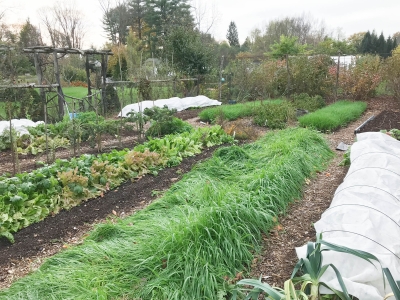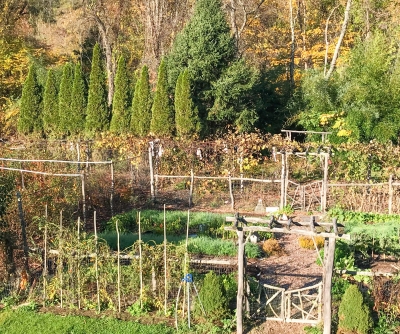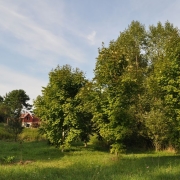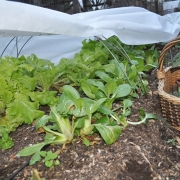The Morning After
Endive Galore
I don’t know if was a case of green thumbness or the weather, but my bed of endive is now almost as frightening as a zucchini planting in summer. The bed, 3 feet wide by 20 feet long, is solid green with endive plants, each and every plant looking as if it’s been pumped up on steroids.
I sowed seeds in 4 by 6 inch seed trays around August 1st, “pricked out” the seedlings into individual growing cells filled with homemade potting soil about a week later, and transplanted them into the garden in the beginning of September. The bed had been home to one of this summer’s planting of sweet corn (Golden Bantam), a heavy feeder, so after clearing the corn I slathered the bed with an inch depth of pure compost.
Perhaps the vigor of these plants also reflects the extra space I gave them. In years past I would cram 3 rows into a 3-foot-wide bed. Because we never can eat all the endive I plant, this year I planted only 2 rows down the bed. Hating to see any wasted space in the garden, I set a row of lettuce transplants, now eaten, up the middle of the bed. The endive plants have opportunistically expanded to fill whatever space they can.
Fortunately, there’s no rush to eat all that greenery. The bigger they get, the more the endives’ leaves fold in on themselves to create blanched, succulent leaves of a loose head. Upcoming cooler weather also brings out the best flavor in these plants. After being covered with clear plastic, which I’ll support with a series of metal hoops, the endive should remain flavorful for weeks to come. That’s assuming the muscular plants can be fit beneath the hoops and plastic.
I do have a Plan B: Just as zucchini bread was invented as a way to deal with zucchini excess, white bean and escarole soup might be just the ticket for my escarole “problem.”
Floating Row Cover
Another bed, planted from seed sown on August 15th, is also full of greenery. Not nearly as dense, though, which is okay because the bed is planted for its roots. Up the bed run 2 rows of turnips and one row of winter radishes.
One year I couldn’t see the turnip and radish bed because I had hidden it beneath a “floating row cover.” Floating row covers, which let water, light, and air pass through, are so lightweight that they can be just laid on top of the ground to be pushed up by growing plants. That year, I made it even easier on my plants by propping the covers up with the same kinds of metal hoops that will hold the clear plastic over the endive bed once the weather turns cold. The row of hoops propping up the plastic creates a tunnel that, every year, looks like a sleeping, giant, white caterpillar. 
The purpose of the floating row cover was to block the root maggots that typically tunnel into many — too many — of my turnip and radish roots. Beneficial nematodes are supposed to help deal with that problem, but have been — in my experience, at least — ineffectual.
This year, for no apparent reason, most of the turnips and radishes are free of maggot attack.
A View From Above
Every morning I look down from my second story bedroom window at the garden. Closest in view is the bed of endive; looking further back, my eyes come to the back of the garden, where a row of tall, thin evergreens stand sentry to block the view of the compost piles. Those evergreens, spires of the Emerald (also known as Smaragd and Emerald Green) variety of arborvitae, are among the commonest of landscape plants. I like them.
The trees are at their upper limit of 15 feet high and 5 feet wide, and create a perfect screen without needing too much elbow room. They’re also perfect for injecting a bit of civility to the more frowsy gooseberry bushes and overgrown (at least till I prune them) grapevines in the foreground. Some arborvitaes turn a muddy green in winter but Emerald keeps its vibrant green color.
To the north, just beyond the garden is another row of spires, five plants of a juniper variety called Gold Cone. Each plant will mature to 10 feet tall with a spread of a mere 3 feet, just enough to hide my Cool Bot walk-in cooler, now home to boxes of apples, pears, pawpaws, cabbages, carrots, and persimmons. Livening things up is the gold coloration at the tips of Gold Cone branches.




This is a really interesting article. I had arborvitaes lining an entire edge of a property I lived at, and it took a good 5 years to get them stable, growing and beautiful.